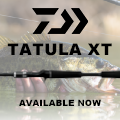https://nrm.dfg.ca.gov/FileHandler.ashx ... 195&inline
B.A.S.S. has since updated and condensed this original guidebook down from 48 pages to just 7 for those with shorter attention spans
https://www.bassmaster.com/wp-content/u ... 20comp.pdf
To give bass the best chance to survive not only to weigh-in time, but also for the next few days after being released, a little extra care is needed when summer water temps are 75 degrees and above. The biggest threat to bass in the live well is insufficient dissolved oxygen, followed by ammonia build up. Water temperature directly effects the amount of dissolved oxygen. Warm water has a lower capacity to absorb DO compared to cooler water and at the same time a bass' DO requirement to survive increases the warmer the water gets. The recommendation for summer months is to control your live well temperature using ice to cool them about 10 degrees, close off the inflow of warm outside lake water, and run pumps on recirculate. This will create the highest amount of DO in your tanks and also help lower the amount of DO your bass require to survive. Since your livewell will not be taking on fresh water you should also perform a 50% water exchange to reduce ammonia build up every 3-4 hourse. A lot of guys like to continuously pump in lake water which is what's recommended when water temperature is below 75. But this changes once temp exceeds 75, it's important to remember the lake water being pulled in comes from the surface which is going to be the warmest and have the least amount of DO in the entire lake. The authors make the point that bass alive at weigh in timewhich appear healthy can still die post release during summer months if they've experienced stress in the live well so taking a few extra steps to reduce stress gives them the best chance to fight another day.
The authors say they cannot officially recommend live well treatments since they are not FDA approved. This is not to say live well treatments are bad in any way nor to say they don't offer benefit to the fish, just that they are not approved for human consumption. Whether you prefer Sure Life Labs (Please Release Me & Catch and Release), G-juice, or Rejuvenade I'm a believer they all help the fish by sedating them (calm fish require less DO and reduce chance of injuring themselves), neutralizing chlorine from ice, add needed salt which helps lower stress and stimulate slime coat production.
The authors also state they do not recommend hydrogen peroxide (H2O2)because too much can be very harmful and possibly kill your fish. The flip side to that is used in the correct dosage (just like any medication) it can saturate your live wells with DO and be a tremendous benefit. Both the late Doug Hannon and Sure Live Labs have videos out recommending the use of hydrogen peroxide in the correct dosage of 1oz of 3% solution per each 3-5 gallons of water. Or about 4oz for a typical 15-18 gallons live well. Use a 3 or 5 gallon bucket to measure your live well up the the overflow (or wherever your normally fill it too) to know for sure.
On a personal note, a few years ago I had all 5 fish die in a hot tournament which cost us the win and was all my fault. I always plug the overflow drain during the hot months to prevent water from escaping when running around and to prevent warm surface water from coming in when moving in reverse. Well, on this day I filled my live wells beyond the level of the plugged overflow mistakingly thinking the more water in there the better. What I failed to consider was once we added 5 big post spawn bass, they displaced enough water so that my spray jets were completely submerged and all five quickly died from a lack of DO.

































 Advertising
Advertising